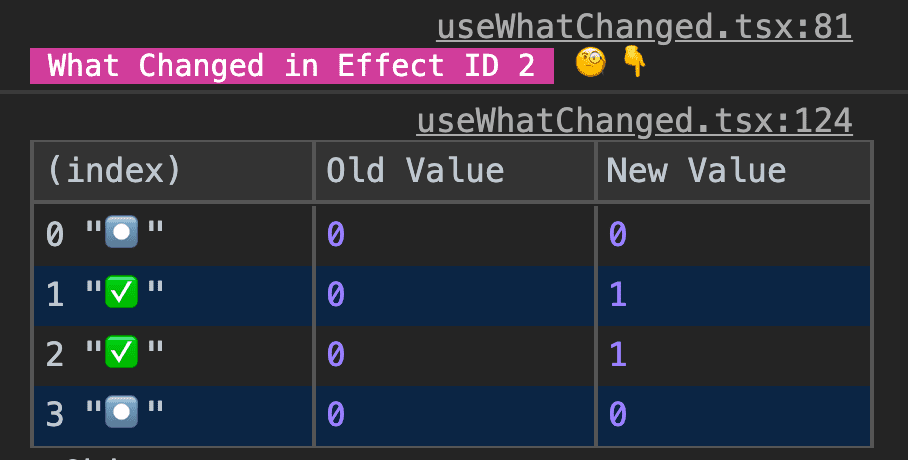1 引言
使用 React Hooks 的时候,经常出现执行次数过多甚至死循环的情况,我们可以利用 use-what-changed 进行依赖分析,找到哪个变量引用一直在变化。
据一个例子,比如你尝试在 Class 组件内部渲染 Function 组件,Class 组件是这么写的:
class Parent extends React.PureComponent { state = { text: "text", }; render() { return <Child setText={(text) => this.setState({ text })} />; } }
子组件是这么写的:
const Child = ({ setText }) => { useEffect(() => { setText("ok"); }, [setText]); return null; };
那么恭喜你,写出了一个最简单的死循环。这个场景里,我们本意是利用 useEffect 调用 props.setText 更新父组件的 text,但执行 props.setText 会导致父组件重渲染,由于父级 setText={(text) => this.setState({ text })} 的写法,每次重渲染拿到的 props.setText 引用都会变化,因此再次触发了 useEffect 回调执行,进而触发死循环。
仅仅打印出值是看不出变化的,引用的改变很隐蔽,为了判断是否变化还得存储上一次的值做比较,非常麻烦,use-what-changed 就是为了解决这个麻烦的。
2 精读
use-what-changed 使用方式如下:
function App() { useWhatChanged([a, b, c, d]); // debugs the below useEffect React.useEffect(() => { // console.log("some thing changed , need to figure out") }, [a, b, c, d]); }
将参数像依赖数组一样传入,刷新页面就可以在控制台看到引用或值是否变化,如果变化,对应行会展示 ✅ 并打印出上次的值与当前值:

第一步是存储上一次依赖项的值,利用 useRef 实现:
function useWhatChanged(dependency?: any[]) { const dependencyRef = React.useRef(dependency); }
然后利用 useEffect,对比 dependency 与 dependencyRef 的引用即可找到变化项:
React.useEffect(() => { let changed = false; const whatChanged = dependency ? dependency.reduce((acc, dep, index) => { if (dependencyRef.current && dep !== dependencyRef.current[index]) { changed = true; const oldValue = dependencyRef.current[index]; dependencyRef.current[index] = dep; acc[`"✅" ${index}`] = { "Old Value": getPrintableInfo(oldValue), "New Value": getPrintableInfo(dep), }; return acc; } acc[`"⏺" ${index}`] = { "Old Value": getPrintableInfo(dep), "New Value": getPrintableInfo(dep), }; return acc; }, {}) : {}; if (isDevelopment) { console.table(whatChanged); } }, [dependency]);
- 直接对比 deps 引用,不想等则将
changed设为 true。 - 调试模式下,利用 console.table 打印出表格。
- 依赖项是 dependency,当依赖项变化时才打印 whatChanged。
以上就是其源码的核心逻辑,当然我们还可以简化输出,仅当有引用变化时才打印表格,否则只输出简单的 Log 信息:
if (isDevelopment) { if (changed) { console.table(whatChanged); } else { console.log(whatChanged); } }
babel 插件
最后 use-what-changed 还提供了 babel 插件,只通过注释就能打印 useMemo、useEffect 等依赖变化信息。babel 配置如下:
{ "plugins": [ [ "@simbathesailor/babel-plugin-use-what-changed", { "active": process.env.NODE_ENV === "development" // boolean } ] ] }
使用方式简化为:
// uwc-debug React.useEffect(() => { // console.log("some thing changed , need to figure out") }, [a, b, c, d]);
将 Hooks 的 deps 数组直接转化为 use-what-changed 的入参。
3 总结
use-what-changed 补充了 Hooks 依赖变化的调试方法,对于 React 组件重渲染分析可以利用 React Dev Tool,可以参考 精读《React 性能调试》。
还有哪些实用的 Hooks 调试工具呢?欢迎分享。
本文作者:前端小毛
本文链接:
版权声明:本博客所有文章除特别声明外,均采用 BY-NC-SA 许可协议。转载请注明出处!
